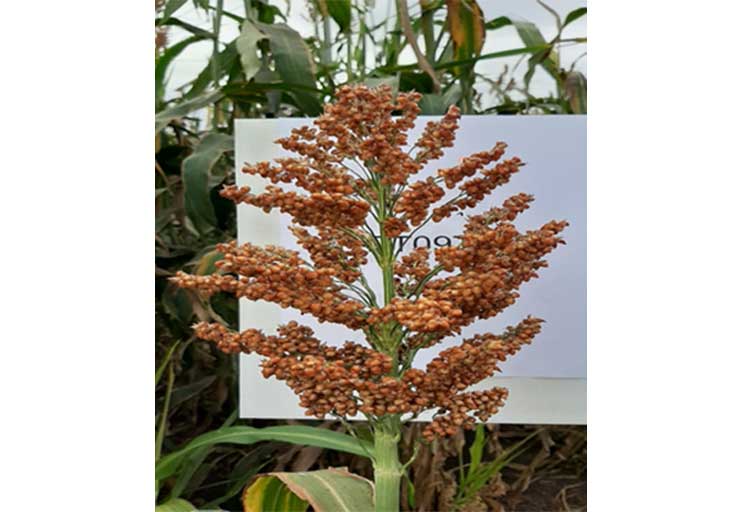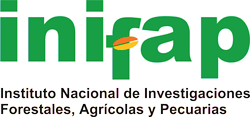VCS-Fuego, a dual-purpose sorghum variety for the state of Sinaloa
DOI:
https://doi.org/10.29312/remexca.v16i1.3151Keywords:
Sorghum bicolor, breeding, forage, yieldAbstract
The VCS-Fuego sorghum variety was developed at the Valle de Culiacán Experimental Field (CEVACU) of the National Institute of Forestry, Agricultural, and Livestock Research (INIFAP) and registered with the definitive number SOG-317-240521 in the National Catalog of Plant Varieties (CNVV) of the National Seed Inspection and Certification Service (SNICS) and breeder’s title number 2968 in favor of INIFAP. It was developed from 2009 to 2017 in the state of Sinaloa, where hybrids or commercial varieties susceptible to diseases and plant lodging are predominantly sown. VCS-Fuego is a variety with an intermediate vegetative cycle, with amber grains; it is recommended for irrigated and rainfed conditions. The average yield of the variety is 3.95 t ha-1 of grain and 35 t ha-1 of fresh forage. VCS-Fuego has good bromatological quality in forage, with 6.72% protein and 79.07% digestibility, has a grain size of 5.03, 4.09, and 3.02 mm in length, width and thickness, and a chemical composition of proteins, lipids, and carbohydrates of 14.78, 3.62, and 80.03%, respectively; therefore, VCS-Fuego is proposed as a potential variety to be grown in the state of Sinaloa.
Downloads
References
Dicko, M. H.; Gruppen, H.; Traore, A. S.; Voragen, A. G. and Van-Berkel, W. J. 2006. Review: sorghum grain as human food in Africa: relevance of starch content and amylase activities. African Journal of Biotechnology. 5(5):384-395. https://www.researchgate.net/publication/279562585-Sorghum-grain-as-human-food-in-Africa-Relevance-of-content-of-starch-and-amylase-activities.
González, R.; Ávila, J. y Pieruzzini, N. 2005. Manejo de las principales enfermedades del sorgo en el estado portuguesa. Aspectos Fitosanitarios. 6:29-32. http://sian.inia.gob.ve/inia-divulga/divulga-06/rid6-gonzalez-29-32.pdf.
Hernández-Espinal, L. A.; Moreno-Gallegos, T.; Reyes-Jiménez, J. E. y Loaiza-Meza, A. 2011. PERLA-101: Nueva variedad de sorgo para el estado de Sinaloa. Revista Mexicana de Ciencias Agrícolas. 2(5):779-784. Doi: https://doi.org/10.29312/remexca.v2i5.1629.
Hernández-Espinal, L. A.; Moreno, G. T.; Loaiza, M. A. y Reyes, J. J. E. 2010. Gavatero-203: nueva variedad de sorgo forrajero para el estado de Sinaloa. Revista Mexicana de Ciencias Agrícolas. 1(5):727-731. http://www.scielo.org.mx/scielo.php?script=sci-arttext&pid=S2007-09342010000500013
Maya-Hernández, V. y Rodríguez-Bosque, L. A. 2014. Pulgón amarillo: una nueva plaga del sorgo en Tamaulipas. 88 p. http://biblioteca.inifap.gob.mx:8080/jspui/bitstream/handle/123456789/3806/pulgon-amarillo-mayah.pdf?sequence=1.
Moreno-Gallegos, T.; López-Guzmán, J. A.; Gutiérrez-Gutiérrez, O. G.; Pérez-Márquez, J.; Cortez-Mondaca, E. y Moreno-Hernández, J. M. 2020; Guía para producir sorgo bajo sistema de riego y temporal en Sinaloa. Folleto técnico núm. 68. 42 p. ISBN:978-607-37-1265-1.
Reichert, R. D.; Mwararu, M. A. and Mukuru, S. Z. 1988. Characterization of colored grain sorghum lines and identification of high tannin lines with good dehulling characteristics. Cereal Chem. 65(3):165-170. https://www.aaccnet.org/publications/cc/backissues/1988/Documents/65-165.pdf.
Rooney, L. W. and Serna-Saldívar, S. O. 2000. Sorghum. In: Kulp, K. and Ponte, J. G. Jr. Handbook of cereal science and technology. 2nd Ed. New York: Marcel D. 149-176 pp.
Serna-Saldívar, S. 2010. Cereal Grains: properties, processing, and nutritional attributes. CRC Press. Boca Ratón, FL. 752 p. ISBN: 9780429112119.
SIAP. 2023. Servicio de Información y Estadística Agroalimentaria y Pesquera. https://nube.siap.gob.mx/cierreagricola/.
Sharman, C. H; Sharma, P. S. and Munghate, R. S. 2013. Phenotyping for resistance to the sugarcane aphid Melanaphis sacchari (Hemiptera: Aphididae) in Sorghum bicolor (Poaceae). International Journal of Tropical Insect Science. 33(4):227-238. https://doi.org/10.1017/S1742758413000271.
Williams-Alanís, H.; Pecina-Quintero, V.; Montes-García, N.; Palacios- Velarde, O.; Arcos-Cavazos, G. y Vidal-Martínez, V. A. 2009. Reacción de variedades de sorgo [Sorghum bicolor (L.) Moench.] para grano a Macrophomina phaseolina (Tassi) Goid. Revista Mexicana de Fitopatología. 27(2):148-155. http://www.scielo.org.mx/scielo.php?script=sci-arttext&pid=S018533092009000200007.

Published
How to Cite
Issue
Section
License
Copyright (c) 2025 Revista Mexicana de Ciencias Agrícolas

This work is licensed under a Creative Commons Attribution-NonCommercial 4.0 International License.
The authors who publish in Revista Mexicana de Ciencias Agrícolas accept the following conditions:
In accordance with copyright laws, Revista Mexicana de Ciencias Agrícolas recognizes and respects the authors’ moral right and ownership of property rights which will be transferred to the journal for dissemination in open access. Invariably, all the authors have to sign a letter of transfer of property rights and of originality of the article to Instituto Nacional de Investigaciones Forestales, Agrícolas y Pecuarias (INIFAP) [National Institute of Forestry, Agricultural and Livestock Research]. The author(s) must pay a fee for the reception of articles before proceeding to editorial review.
All the texts published by Revista Mexicana de Ciencias Agrícolas —with no exception— are distributed under a Creative Commons License Attribution-NonCommercial 4.0 International (CC BY-NC 4.0), which allows third parties to use the publication as long as the work’s authorship and its first publication in this journal are mentioned.
The author(s) can enter into independent and additional contractual agreements for the nonexclusive distribution of the version of the article published in Revista Mexicana de Ciencias Agrícolas (for example include it into an institutional repository or publish it in a book) as long as it is clearly and explicitly indicated that the work was published for the first time in Revista Mexicana de Ciencias Agrícolas.
For all the above, the authors shall send the Letter-transfer of Property Rights for the first publication duly filled in and signed by the author(s). This form must be sent as a PDF file to: revista_atm@yahoo.com.mx; cienciasagricola@inifap.gob.mx; remexca2017@gmail.
This work is licensed under a Creative Commons Attribution-Noncommercial 4.0 International license.


